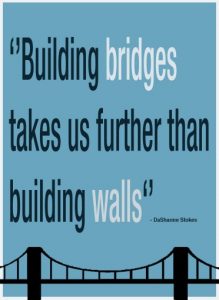Cinema-Communications: Resist Violence Winter 2017
May 4th - 5th, 2017On May 4 and 5, a multimedia exhibit will be held. The Resist Violence 2017 event will feature works from all of the students involved in the paired Cinema/Communications and Humanities course, Imaging Violence and Nonviolence. The projects that will be showcased are related to the subject of resisting violence with the theme of “checkpoints”, to be interpreted in various ways, for example we plan on turning Conrod’s into a border crossing checkpoint.
Resist Violence: Borders
From the Turkish shores near Bodrum, to the threatened US – Mexican wall, we are contemplating borders in ways that challenge our understanding of human rights. This term’s Resist Violence exhibit will question what it means to cross a border and the dehumanizing, discriminatory process we have normalized, asking: are we more secure? Join us in Conrod’s to experience this and many other awareness raising media projects made by students in the paired Humanities + Cinema-Communications class “Imaging Violence and Nonviolence.”
Project Update
This term’s Re sist Violence: Borders was very well attended and gained the curiosity of many staff, faculty and student bodies.
sist Violence: Borders was very well attended and gained the curiosity of many staff, faculty and student bodies.
Overall, the project’s aim at turning Conrod’s into a border crossing to raise awareness about discriminatory practices at security check
points, preventing refugees from fleeing violent contexts in their countries of origin (an idea brought to the class by student Matthew Gravas) really solicited some stories and sharing with visitors about their own experiences. Other students in the Imaging Violence + Nonviolence class contributed by making poster, video and interactive projects that aimed to raise awareness about the violence normalized around us. The categorization of child abuse, reflection on the refugee crisis, the limitations of the justice system addressing sexual assault, and the
narrative of injustices in our world reflected through the Human project (an online way of connecting through stories and differences) are just a few examples of the projects exhibited. All these projects aimed at resisting violence were initiated and conducted by students, except a few posters with statistics and quotes researched by Pat Romano, who teaches the Humanities component, made in collaboration with students. This was the first time I saw students really display what they had learned in the Humanities component at the exhibit (which was our overall aim). Other learning communities like the Model UN, SPACE, and the Peace Centre were involved in making this exhibit a success. Whether lending a hand to set up, lending equipment or providing materials to make media and fill the exhibit space with.
It occurred to us as we were preparing the exhibit, that this was the start of a larger movement, and that students were learning the root causes of violence, and in so doing were equipped to resist it with media literacy strategies being employed. Although this is just a semester’s worth of effort, students seemed to really have benefitted from the work they did in the class, and often spoke to us about how it has influenced them in other classes and with other projects, and even with the conversations they are having at home or with friends. Although this kind of project-based teaching is very labor intensive, it would seem very useful and important for students and those in the college choosing to be involved. Students learned all sorts of really important skills. Team- work, promotional strategies, how to engage a wider audience, web
design, curating themes, addressing injustices through social experiments and media making, organizing and planning logistics to name a few.



